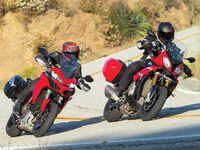Just in time for the Thanksgiving holiday, Ducati dropped off a fully updated 2015 Multistrada S Touring. By that I mean that it packs the latest programming for its many on-board computers that has, I'm delighted to say, unlocked all the goodness I knew was in the bike all along.
The Multistrada with variable valve timing was superlative at the press launch in Europe but deeply flawed by the time it reached our shores. (A Euro-spec bike we rented in Europe had the same problems, so they weren’t limited to US-bound bikes.) Our first Multi felt to me as though Ducati’s engineers encountered issues with noise or emissions that they couldn’t resolve with the mapping present on the launch bikes.
Put that in the past. With new coding, the Multi is as it should be: strong off the bottom, solid in the middle, and stout at the top. Where the previous-spec bike had a massive hole in the midrange and dodgy throttle response, the current tune gives a smoother, flatter torque curve in the middle and far more predictable responses. It is now a pleasure to ride.
When we gave Ducati the award for Best New Technology—for the DVT, or Ducati Variable Timing—I was confident that the idea itself would prove to be a significant step, as it has been in cars. In the Multi, the benefits are dramatically smoother running at low revs and newfound flexibility. If you've ridden the previous Multi, you know the Testastretta 11° engine is powerful but still a bit superbike-brutish, unwilling to chug along at low rpm and high load, seemingly screaming at you to keep the revs up and kiss the rev limiter like a new lover's lips—as often as you dare. In every sense, the fixed-timing Testastretta almost feels shipped straight from the racetrack, tamed just enough for the street.
Here’s the cool part of all this: Ducati fixed the Multistrada without changing a single physical part. All of the current bike’s fine manners and flexible nature were there from the start; it just took the right set of programs to bring them out. Think about that. In years past, a bike released before its time might need new components to make it right or to counter problems found in the field after its introduction. Or it might not get fixed at all, with a running change made to the following year’s bike that leaves you, Mr. Early Adopter, hosed.
Welcome to the reality of computer-studded modern motorcycles. And I consider that emphasis a benefit. Even if the first examples aren’t quite what they should be, there’s a chance they’ll get fixed, as was the case with the Multi and, for that matter, Yamaha’s FZ-09, whose first-year RBW was far less than ideal. Emphasis on computer control is the way manufacturers get so much power, meet emissions and noise regulations, and still provide bikes that a human can manage. What it takes instead of a willingness to change components after the fact is patience that the original manufacturer (or an enterprising aftermarket type with the right programming chops) will eventually send you a collection of ones and zeros that makes your bike really sing.











/cloudfront-us-east-1.images.arcpublishing.com/octane/7GJYDUIPXRGMTMQKN6ONYOLBOU.jpg)
/cloudfront-us-east-1.images.arcpublishing.com/octane/MUQLOVLL2ZDGFH25ILABNBXKTI.jpg)
/cloudfront-us-east-1.images.arcpublishing.com/octane/TNOU5DNE2BC57MFPMGN2EIDXAM.jpg)
/cloudfront-us-east-1.images.arcpublishing.com/octane/GTCXACQGJ5HAPDTGWUQKDEH44E.jpg)
/cloudfront-us-east-1.images.arcpublishing.com/octane/S35YGSEMEZB4BLTDJTSZPF4GLA.jpg)
/cloudfront-us-east-1.images.arcpublishing.com/octane/5UOT6HPX2JFMRJAX6EH45AR4MQ.jpg)
/cloudfront-us-east-1.images.arcpublishing.com/octane/OKWOJWAKP5EP3OACCRRWPCIX2Q.jpg)
/cloudfront-us-east-1.images.arcpublishing.com/octane/2WF3SCE3NFBQXLDNJM7KMXA45E.jpg)
/cloudfront-us-east-1.images.arcpublishing.com/octane/G4MG6OUCJNBSHIS2MVVOTPX65E.jpg)
/cloudfront-us-east-1.images.arcpublishing.com/octane/IIGGWFOTOJGB7DB6DGBXCCMTDY.jpg)
/cloudfront-us-east-1.images.arcpublishing.com/octane/QSTCM6AVEZA5JJBUXNIQ3DSOF4.jpg)
/cloudfront-us-east-1.images.arcpublishing.com/octane/U4I7G625B5DMLF2DVIJDFZVV6M.jpg)
/cloudfront-us-east-1.images.arcpublishing.com/octane/B6XD6LS6IVCQPIU6HXDJSM3FHY.jpg)
/cloudfront-us-east-1.images.arcpublishing.com/octane/ICL63FEDDRDTTMINYICCEYGMDA.jpg)
/cloudfront-us-east-1.images.arcpublishing.com/octane/FCGZHQXRBZFLBAPC5SDIQLVF4I.jpg)
/cloudfront-us-east-1.images.arcpublishing.com/octane/WNOB6LDOIFFHJKPSVIWDYUGOPM.jpg)

/cloudfront-us-east-1.images.arcpublishing.com/octane/X33NU3E525ECRHXLNUJN2FTRKI.jpg)
/cloudfront-us-east-1.images.arcpublishing.com/octane/6KKT5NNL2JAVBOXMZYS5ZO76YA.jpg)
/cloudfront-us-east-1.images.arcpublishing.com/octane/J5RKG5O455GMPGQRF2OG6LRT7A.jpg)
/cloudfront-us-east-1.images.arcpublishing.com/octane/GX2CIZKQVRH2TATDM26KFG2DAE.jpg)
/cloudfront-us-east-1.images.arcpublishing.com/octane/ZWIDYSAKQZHD5BHREMQILXJCGM.jpg)
/cloudfront-us-east-1.images.arcpublishing.com/octane/CYUHJZCTSJCH3MRAQEIKXK7SCQ.jpg)
/cloudfront-us-east-1.images.arcpublishing.com/octane/LKOFINY56FCXJCANJ5M7ZDQUBY.jpg)